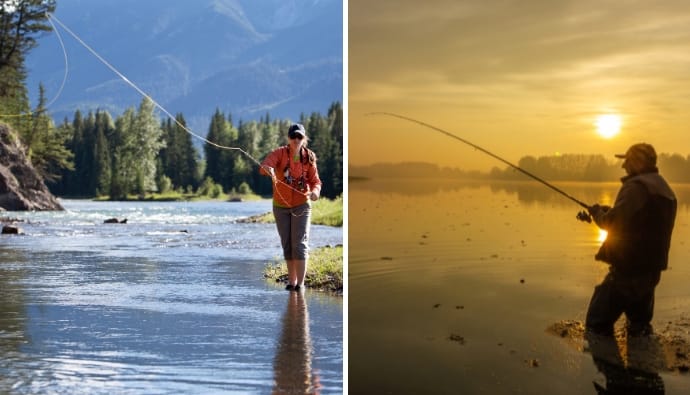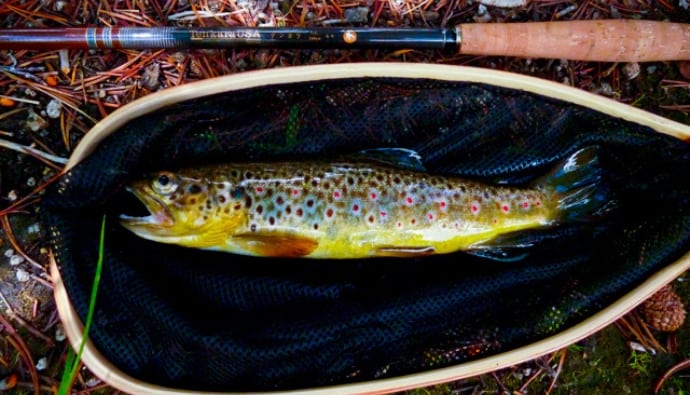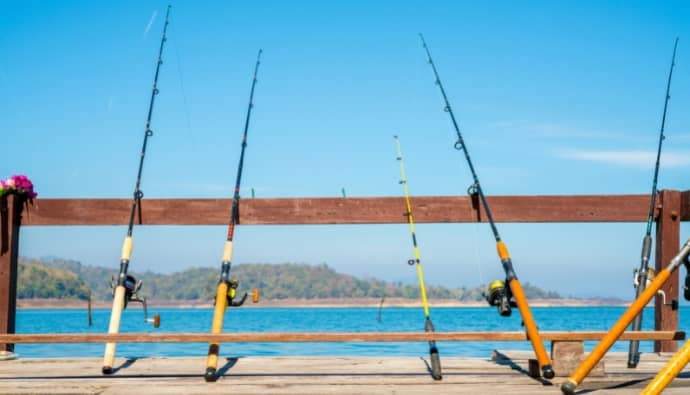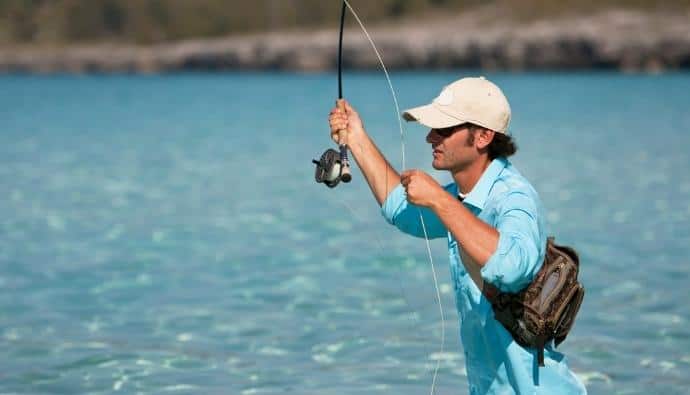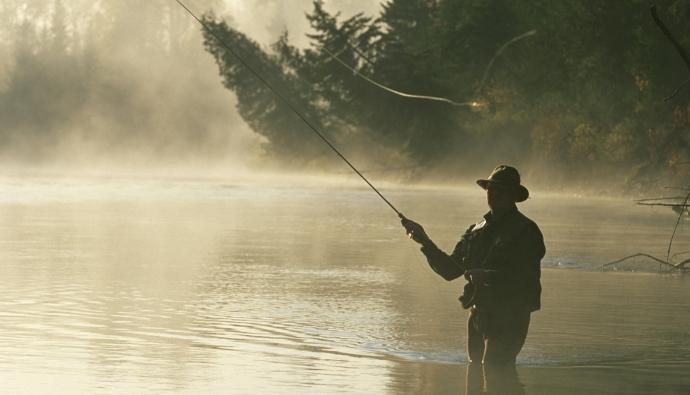Making a switch from freshwater fly fishing to saltwater fly fishing requires changing more than just the location.
Saltwater fly fishing is fundamentally different from freshwater fly fishing due to the size and strength of the fish, the demands of saltwater as well as the weather conditions.
Saltwater fish are known to be bigger and stronger than freshwater fish. Saltwater is corrosive and will destroy gear that is not suited to the conditions, and you also have to deal with the wind while fishing.
This is why it is important to get gear designated for saltwater fishing when starting your career. We have put together a saltwater fly fishing gear guide to provide all the information that you need.
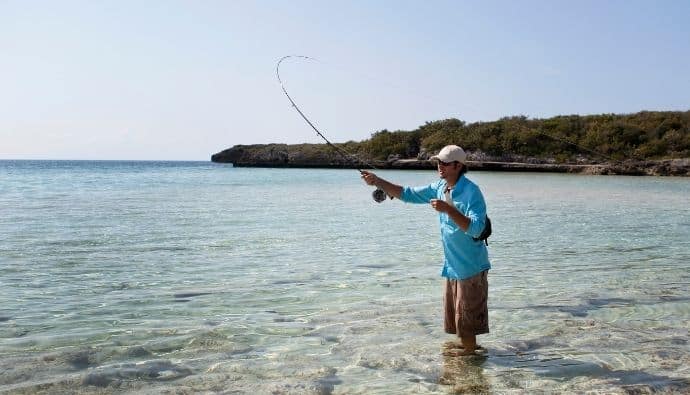
Essential Saltwater Fly Fishing Gear
There are saltwater fly fishing gear that are essential for the success of your fishing trip. We have highlighted some of these gear below, along with the factors to consider when choosing one.
Saltwater Fly Rod
The first gear to get is your saltwater rod. The rod is very instrumental to your ease, speed and accuracy of your casting.
For saltwater fishing, you want to get saltwater fly rods that are built strong due to the heavy saltwater fish that you are sure to catch. Things to consider when choosing a saltwater rod includes the line weight, length, material as well as action.
There are different line weights to choose from, depending on the species that you are fishing for. For bonefish and redfish, 8 weight rod is ideal. 10 weight rod works best for permit, false albacore, stripped bass and roosterfish.
For a tarpon, it is best to go with an 11 weight rod. A giant trevally might require a 12 weight rod, while a sailfish can be caught using a 14 weight rod. If you want a light saltwater rod that is versatile, then choose a 9 weight rod.
If you are looking for a heavy saltwater rod that is versatile and multi-purpose, then go with a 11 weight rod. When it comes to length, 9-ft rod is the best option for all fishing conditions.
There are three major materials to choose from when it comes to saltwater fly rods. These are graphite, fiberglass, and wood.
Graphite fly rods are commonly used by many anglers, as they usually come with machined aluminum reel seat which provides protection against corrosion. For saltwater fishing, fast-action rods are best, as they allow for faster casting and quick recovery.
Best Choice: Sage X Series Fly Rods
When it comes to fly rods that combine versatility, efficiency, and durability, these fly rods are very flexible with a progressive taper that allows for accurate casting.
With Sage X Series Fly Rods, you can cast saltwater flies of different weights and sizes. Due to their powerful nature, they are great for casting in strong wind.
Other fly rods to consider are G. Loomis Asquith, Sage Igniter Series, and Winston Saltwater Air.
Saltwater Fly Reels
Your rod and reel work together to give you the best fishing experience. As such, getting a saltwater fly reel that matches and complements your fly rod is important.
Just like with fly rods, there are things to consider when choosing a saltwater fly reel. These factors include the size, material, drag system, and arbor reel.
When it comes to material, a machined reel is usually more reliable than a machined-finished one. This is because machined reels are always anodized for protection against saltwater.
You need a large reel for saltwater fishing, as you are dealing with heavy saltwater fish. In the same vein, a large arbor reel is important for faster retrieval, as saltwater fish are significantly stronger and faster than freshwater species. A sealed drag system works best, as great stopping is not required.
Best Choice: Nautilus NV/G Series
The Nautilus NV/G Series saltwater reel stands out for all the right reasons. It is lightweight, inexpensive, durable, smooth, and aesthetically pleasing. It comes with a large arbor spool that allows for quick retrieval.
The drag discs are also sealed, having a bullet-proof housing. It is a machined reel making it a long-lasting choice.
Fly Lines
Saltwater fly lines are designed to cope with the corrosive nature of saltwater. As such, it is important to choose a fly line that is designed specifically for saltwater fishing.
There are three types of fishing lines that are used for saltwater fishing which are intermediate sink, full sink, and floating lines. Floating lines are used by many anglers.
Saltwater Flies
When choosing saltwater flies, it is important to know the species of fish that you are going after. Saltwater fish are divided into two groups based on feeding, which is bottom feeders and predators.
Saltwater fly patterns are structured to resemble crabs, shrimp, and baitfish. The hooks for these flies are made from stainless steel to prevent rust. It is best to travel with a few dozen of saltwater flies in different patterns and sizes to have a successful fishing trip.
To transport your saltwater flies safely, you need a fly box. Your saltwater box should be large enough to carry all your flies.
Other accessories needed for fly fishing are pliers, reel tools, nippers, and nail knot tools. Polarized sunglasses are also essential for protecting your eyes from harmful sun rays.

Tips For Taking Care of Your Saltwater Fishing Gear
Without proper care, you will have to replace your saltwater fishing gear every now and then. To reduce the effect of saltwater on your fishing gear, follow these tips.
Always Rinse
It is crucial that you rinse your saltwater rod and reel after every use. Do this with clean, fresh water. Rinsing your saltwater gear will remove all the dirt, debris as well as salt that stuck to it while fishing.
Do not submerge your reel in water, as this can affect critical areas. Once you have rinsed your rod and reel, clean them with a soft dry cloth and leave them to dry.
Lubrication
Lubricating your reel keeps it in prime condition for a long time. Do not apply lubricant unless the reel is clean and dry. Ensure to take care of the handle and gears.
Storage
Make sure to store your saltwater fishing gear properly whenever it is not in use. It is best to keep them in a cool, dry area to prevent exposure to saltwater. This will keep your saltwater gear in good shape for many years.
You can also take your gear to a professional for a tune-up regularly. This will ensure that high performance is maintained constantly.
Conclusion
Fishing in saltwater can be really tasking, which is why it is important to use the proper saltwater gear. As rods and reels often break while on saltwater trips, it is best to go along with a backup rod and reel.
Rod and reel combos can also be considered, as they are a nice alternative to buying both products separately.
Overall, it is important to know the requirements of your fishing destinations. Be sure to go with your complete saltwater fishing tackle, as well as protective gear to keep you safe. Be polite to other anglers and ensure to have fun.


 Facebook
Facebook YouTube
YouTube
